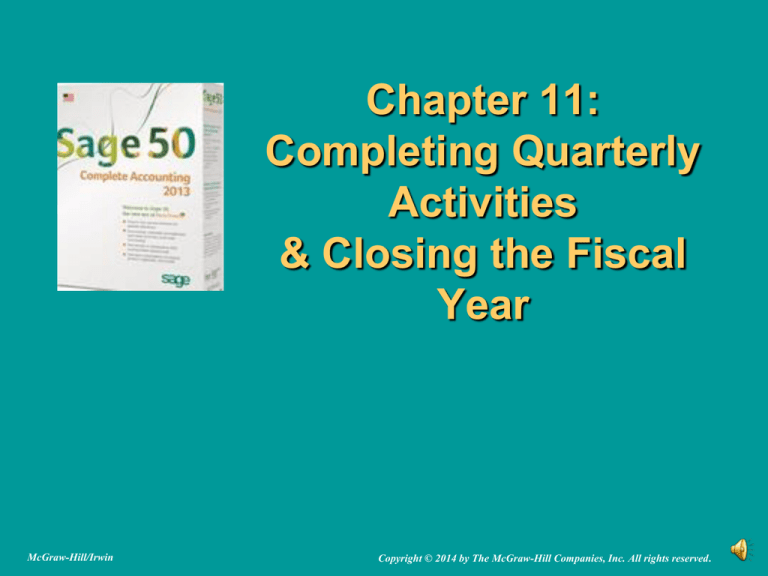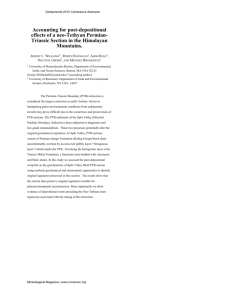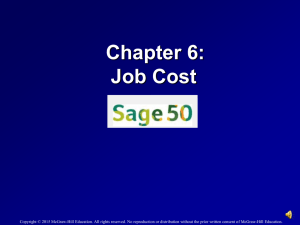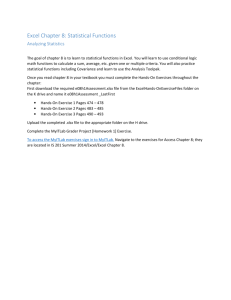
Chapter 11:
Completing Quarterly
Activities
& Closing the Fiscal
Year
McGraw-Hill/Irwin
Copyright © 2014 by The McGraw-Hill Companies, Inc. All rights reserved.
Completing Quarterly Activities
and Closing the Fiscal Year
Chapters 9, 10 and 11 work together. In Chapter
11, you continue recording financial information
for David Walsh Designer. You complete the
Computer Accounting Cycle for November and
December. Mr. Walsh’s transaction registers and
bank statements are used as source documents.
At the end of December, which is also the end of
the fourth quarter, you complete adjusting
entries, print financial statements, and close the
fiscal year.
2 of 18
SCA’s Computer
Accounting Cycle, p. 334
SCA's Computer Accounting Cycle
1. Change accounting periods.
2. Journalize entries.
3. Post entries to the General Ledger.
4. Account Reconciliation.
5. Print the General Ledger Trial Balance (unadjusted).
6. Journalize and post adjusting entries.
7. Print the General Ledger Trial Balance (adjusted).
8. Print the financial statements: Balance Sheet, Income Statement,
Statement of Cash Flow, and Statement of Retained Earnings.
9. Close the fiscal year.
10. Interpret accounting information.
3 of 18
Sage 50 Tips
You must complete Chapters 9 and 10 before starting
Chapter 11.
To check that you have completed Chapter 10, display
David Walsh Designer’s general ledger trial balance.
Compare it to the one shown on page 335. This is the
trial balance at the end of October.
If any of the account balances are incorrect on the
general ledger trial balance, follow the steps for Editing
Journal Entries on page 320. Then, reprint the trial
balance.
4 of 18
Sage 50 Tips (concluded)
If you do not get the correct year-to-date amounts on the
Income Statement (page 361) and Statement of Cash Flow
(page 363), you probably set your chart of accounts
beginning balances in Chapter 9 incorrectly (refer to steps 18, pages 281-286, Entering Chart of Accounts Beginning
Balances).
The Select Period window, From 9/1/13 through 9/30/13, is
shown on page 282 below step 3.
To check that your beginning balances were set up correctly,
display the September 30, 2013 balance sheet (refer to
pages 285-286).
5 of 18
Backing Up Chapter 11
The chart below shows the size of the backups made in Chapter 11. Refer to
textbook pp. 253-254 for sizes of backups (.ptb), Excel files (.xlsx), and Adobe (.pdf)
files in Part 2 - Chapters 9, 10, 11 and Project 1.
Sage 50 Backup (.ptb)
Excel (.xlsx) and Adobe (.pdf)
Chapter 11 November.ptb
Kilobytes
Pages
1,002 KB
346
1,013
353
1,009 KB
364
Chapter 11_Adjusted Trial Balance and Financial
Statements.xlsx
29 KB
364-365
Chapter 11_Adjusted Trial Balance.pdf
50 KB
365
Chapter 11_December Balance Sheet.pdf
5 KB
365
Chapter 11_December Income Statement.pdf
6 KB
365
Chapter 11_December Statement of Cash Flow.pdf
5 KB
365
Chapter 11 December UTB.ptb
Chapter 11 December.ptb
6 of 18
Backing Up Chapter 11 (continued)
Sage 50 Backup (.ptb)
Excel (.xlsx) and Adobe (.pdf)
Chapter 11_December Statement of Retained Earnings.pdf
Kilobytes
Pages
4 KB
365
1,020 KB
372
Chapter 11_Postclosing Trial Balance.xlsx
12 KB
372
Chapter 11_Postclosing Trial Balance.pdf
49 KB
372
Asset depreciation.xlsx (Going to the Net)
14 KB
OLC
Exercise 11-1.ptb
973 KB
376
Exercise 11-2_Unadjusted Trial Balance.ptb
995 KB
378
Exercise 11-2 Financial Statements.ptb
994 KB
379
Exercise 11-2_Adjusted Trial Balance and Financial
Statements.xlsx
29 KB
379
Exercise 11-2_Adjusted Trial Balance.pdf
51 KB
379
5 KB
379
Chapter 11 EOY.ptb
Exercise 11-2_Balance Sheet.pdf
7 of 18
Backing Up Chapter 11 (concluded)
Sage 50 Backup (.ptb)
Excel (.xlsx) and Adobe (.pdf)
Kilobytes
Pages
Exercise 11-2_Income Statement.pdf
6 KB
379
Exercise 11-2_Statement of Cash Flow.pdf
5 KB
379
Exercise 11-2_Statement of Retained Earnings.pdf
4 KB
379
1,005 KB
379
Exercise 11-2_Postclosing Trial Balance.xlsx
12 KB
379
Exercise 11-2_Postclosing Trial Balance.pdf
50 KB
379
Exercise 11-2 End of Year.ptb
8 of 18
Change accounting periods, pp. 336-337
Click on Tasks, then
System. From the System
menu, select Change
Accounting Period. Select
11-Nov 01, 2013 to Nov 30,
2013.
The Change Accounting
Period window is shown on
p. 336.
Click on <OK>. Click on
<No> at the window prompt.
The toolbar shows
.
9 of 18
Data File Statistics, pp. 346-347
From the menu bar, click Help,
Customer Support and Service,
then select File Statistics.
The File Statistics window shows
the shortened name for the
company. If you used your first
and last name Designer, your
shortened company name will
differ. The Data File Statistics
window is shown on page 347.
Click OK to close the Data File
Statistics window.
The shortened company name
that Sage 50 assigns is made
from the first three letters in the
first word, the first three letters in
the second word, and two letters
from the third word.
10 of 18
Glossary of Terms
Chapter 11
11 of 18
General Ledger System,
pp. 333-334
The complete collection of accounts (chart
of accounts) of a company, transactions
associated with these accounts, and
account balances for a specified period of
time. The General Ledger System is the
combination of all journal entries that are
recorded and posted. The account
balances are then shown on the financial
statements.
12 of 18
Unearned revenue, p. 356
Unearned revenue is a liability account
used to report advance collections from
customers or clients.
13 of 18
Online Learning Center
Go online to http://www.mhhe.com/yacht2013 for additional
resources. Link to Student Edition, select Chapter 11.
o
o
o
o
o
o
o
o
Interactive Testing
Glossary of Terms
Feature Quizzes
Narrated PowerPoints
Assessment Rubric
Going to the Net
QA Templates
Appendixes A, B, C, and D are also on the OLC.
14 of 18
Going to the Net
To use an Excel Asset Depreciation Schedule template,
follow these steps.
1.
Start Excel (2003 or later).
2.
Click
; select New.
In the Search box, type Asset Depreciation
Schedule.
Press <Enter>. Double-click on the displayed
depreciation schedule and the download begins.
Complete the fields shown on the next slide and
answer question number 3.
3.
4.
5.
15 of 18
Going to the Net (concluded)
Complete the following fields. Press <Enter> to move
between fields.
Date:
Initial cost:
Salvage value:
Useful life (years)
1.
2.
3.
4.
1/1/2006
7000
0
7
Click on Asset Depreciation. Type Furniture to replace it.
Save. The suggested file name is Asset depreciation
schedule1.xlsx.
What depreciation methods are shown?
Close Excel.
16 of 18
Analysis Questions
When using Sage 50, why is it important to
change accounting periods? (Hint: Do a
search on Sage 50’s Help window for Change
Accounting Period.)
2. Does the balance in retained earnings differ
on the adjusted trial balance and the
postclosing trial balance?
3. How does the postclosing trial balance differ
from the adjusted trial balance?
1.
17 of 18
Assessment Rubric
Task
Date
Navigation Center
Task
Window
Ending GL
Balance
December bank
reconciliation
David Walsh
Designer
18 of 18






